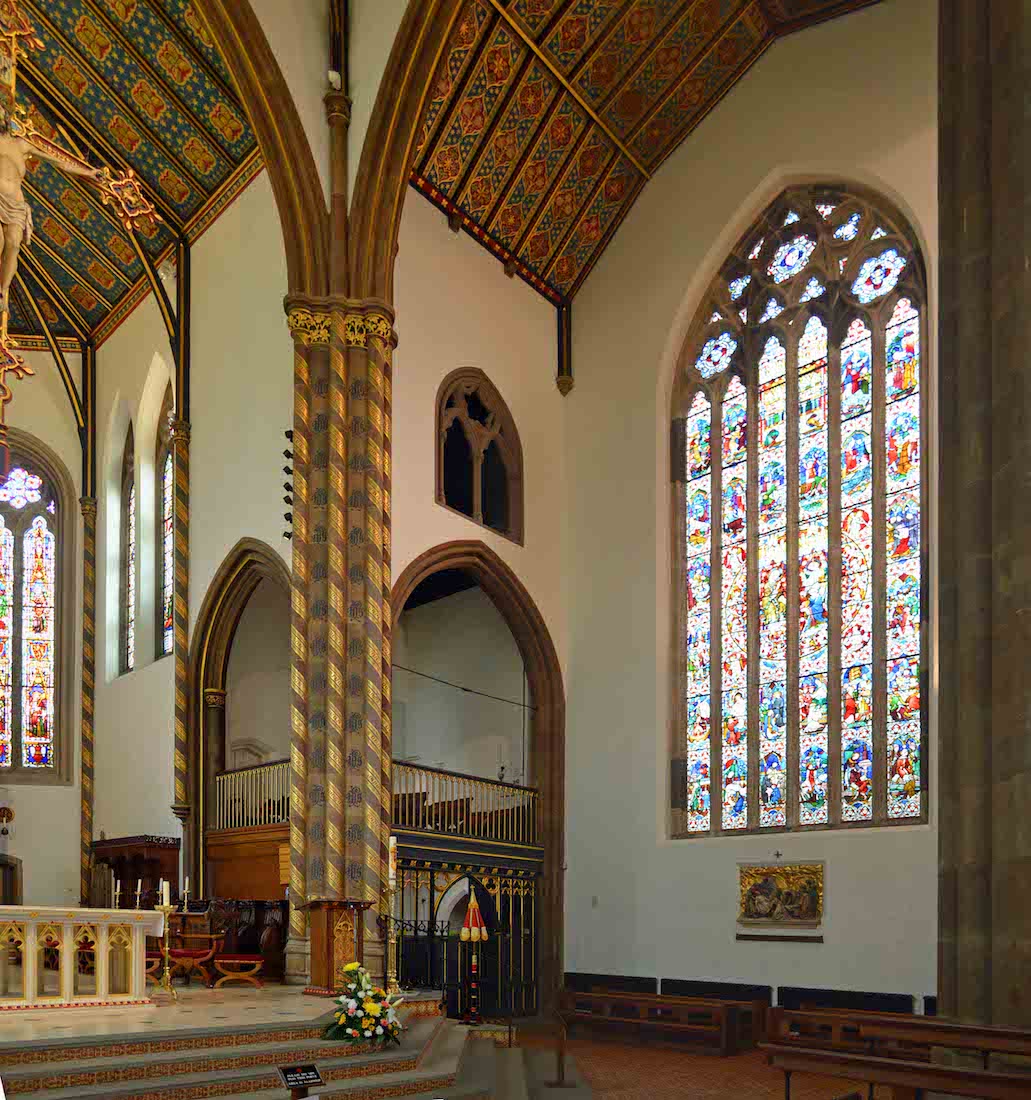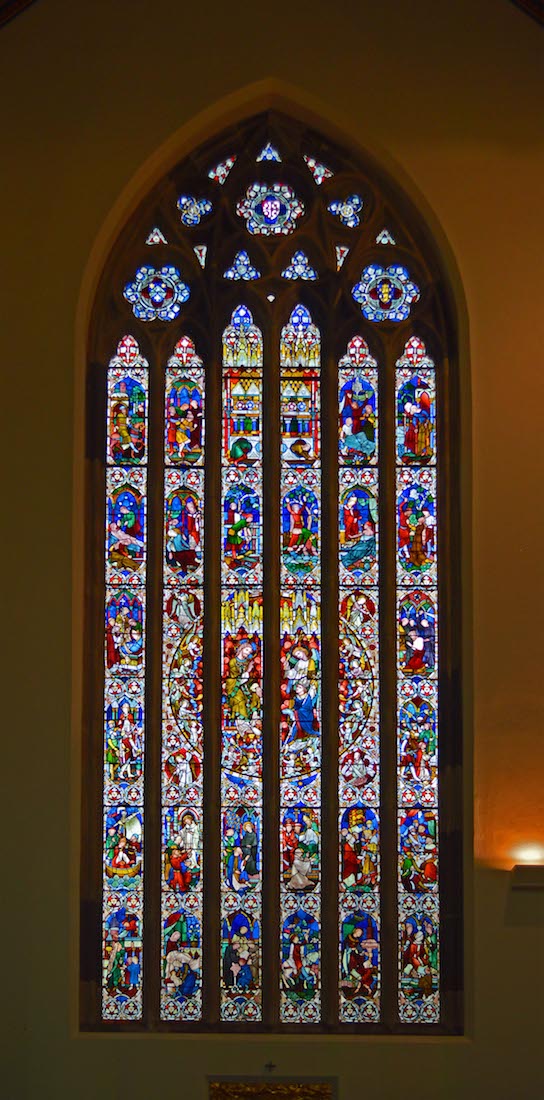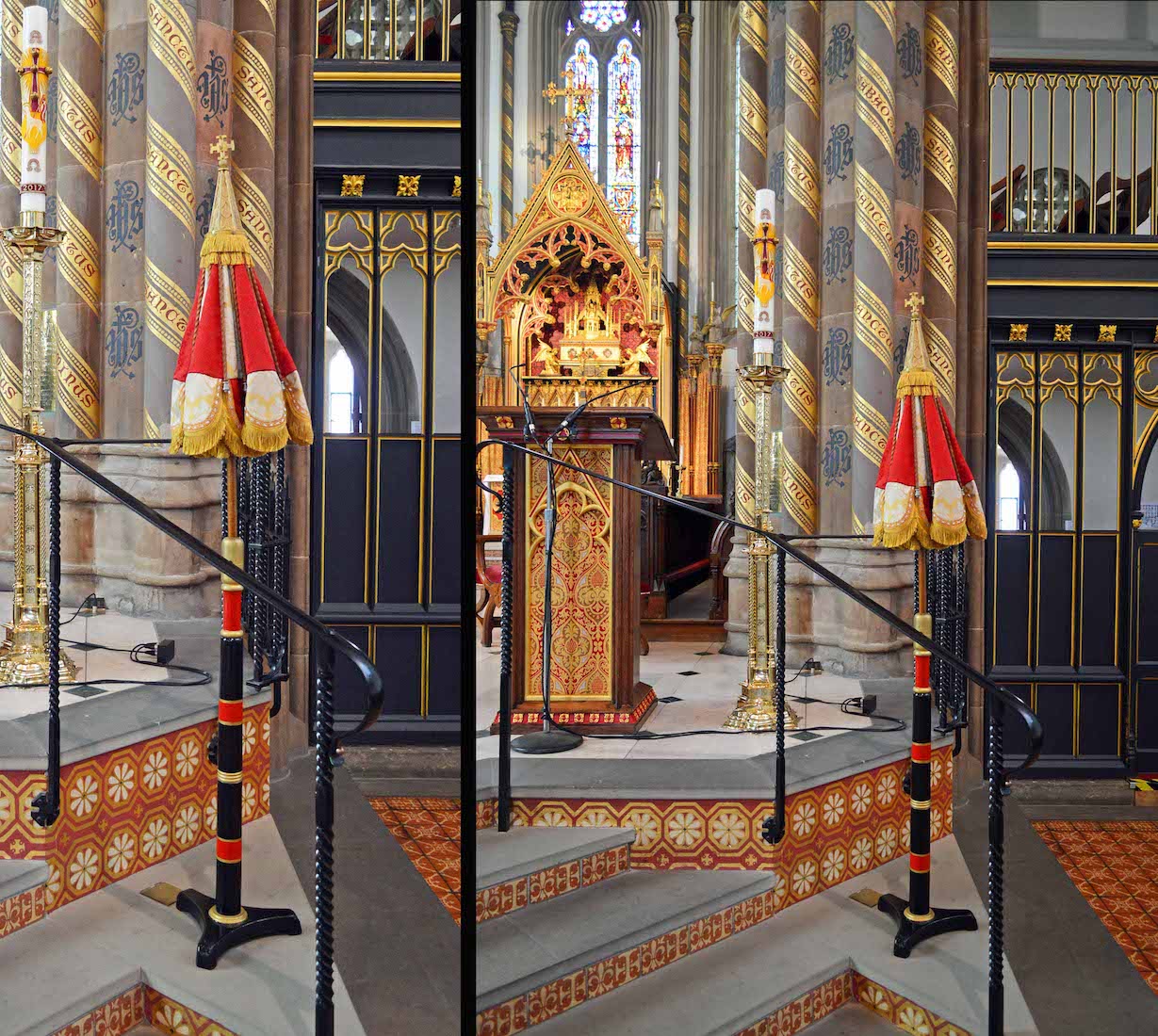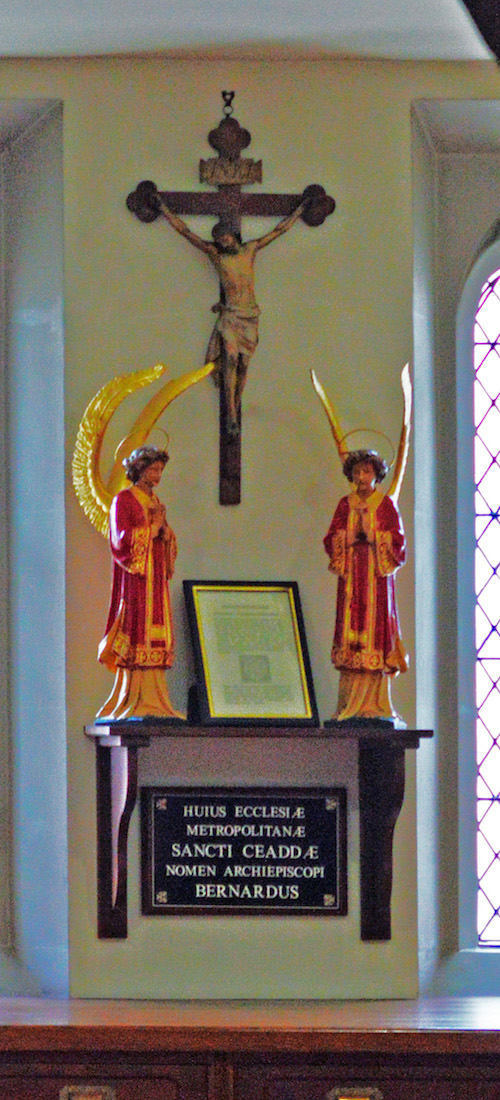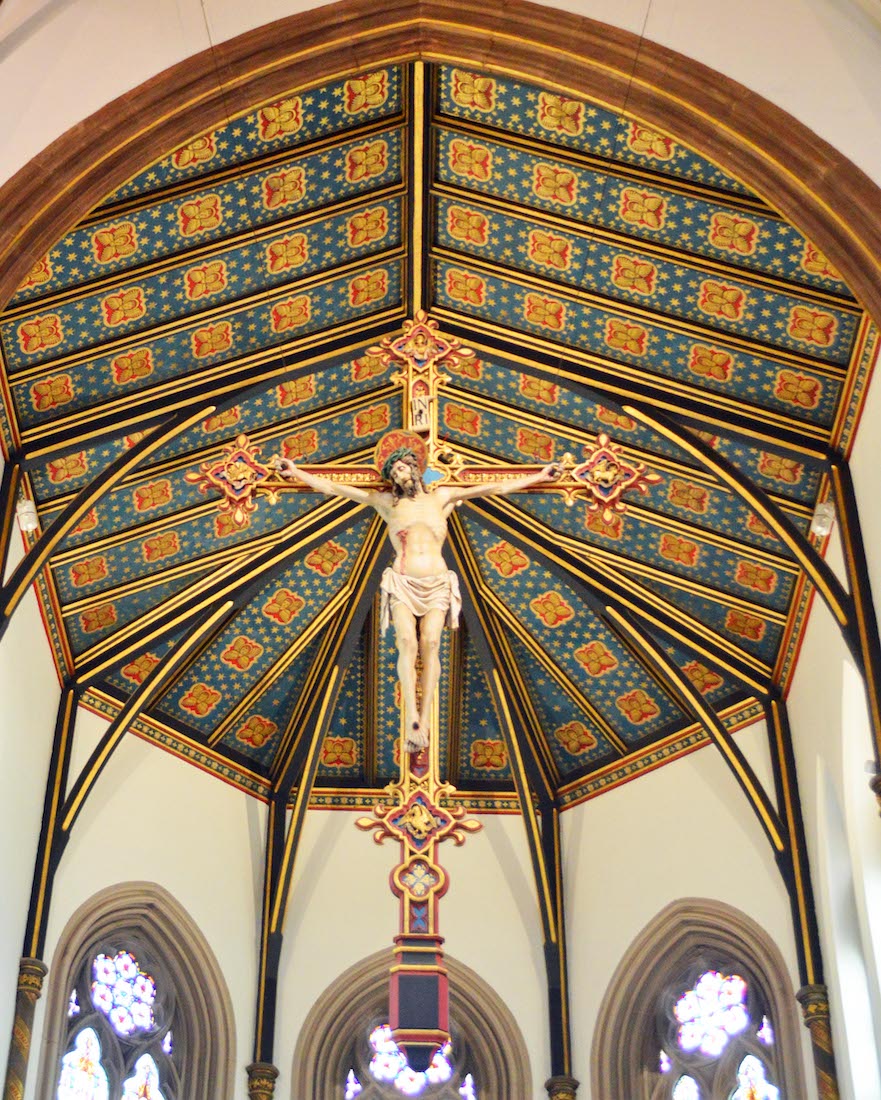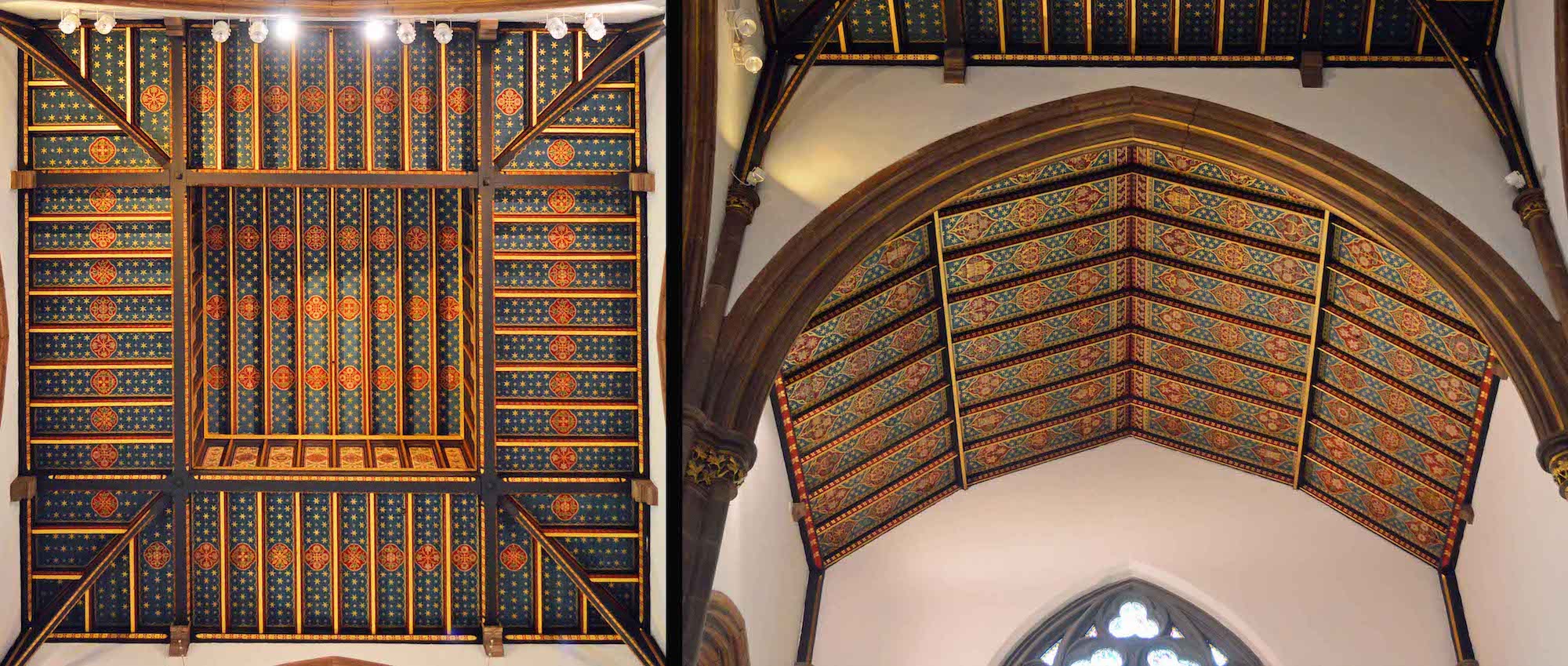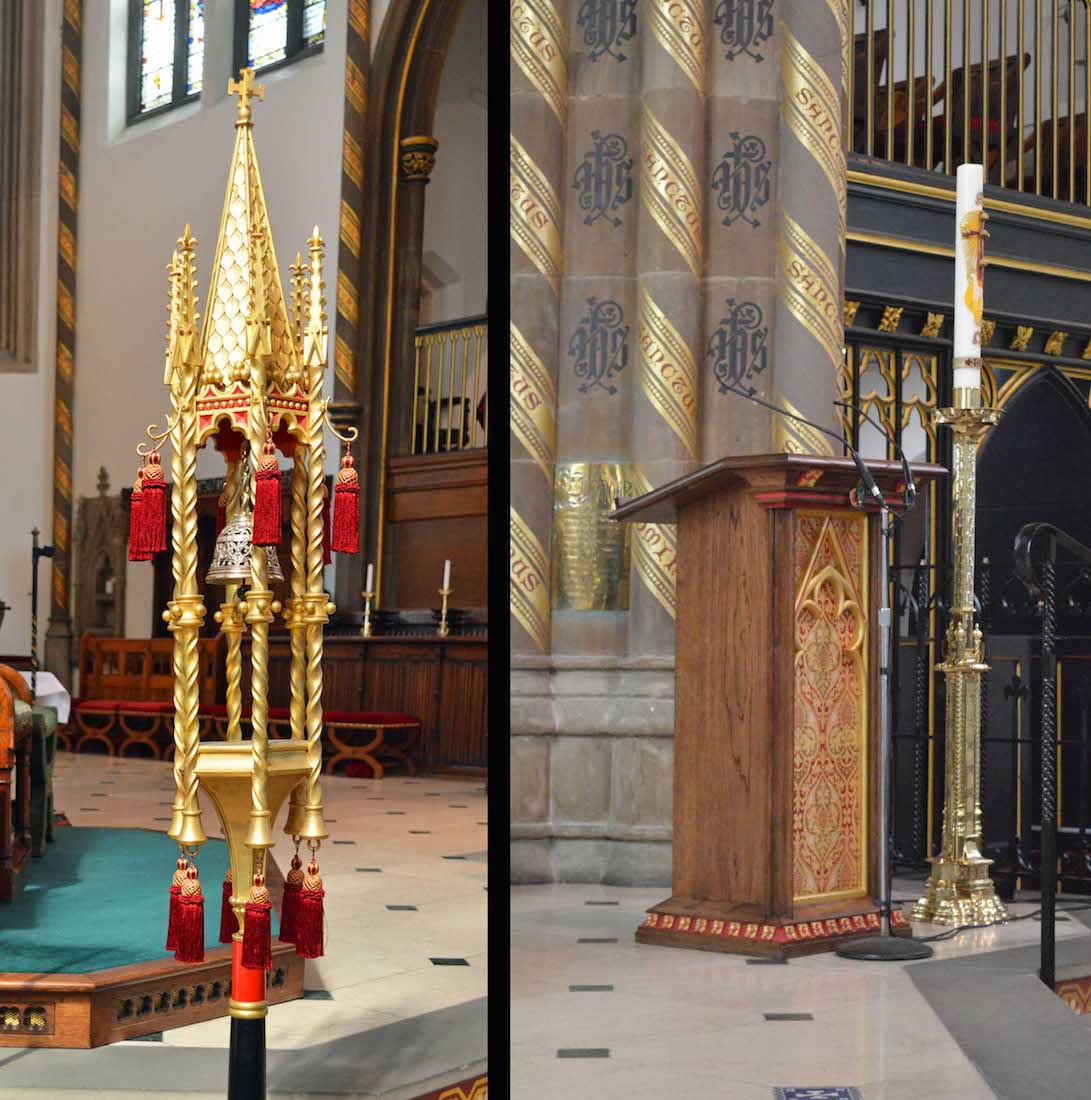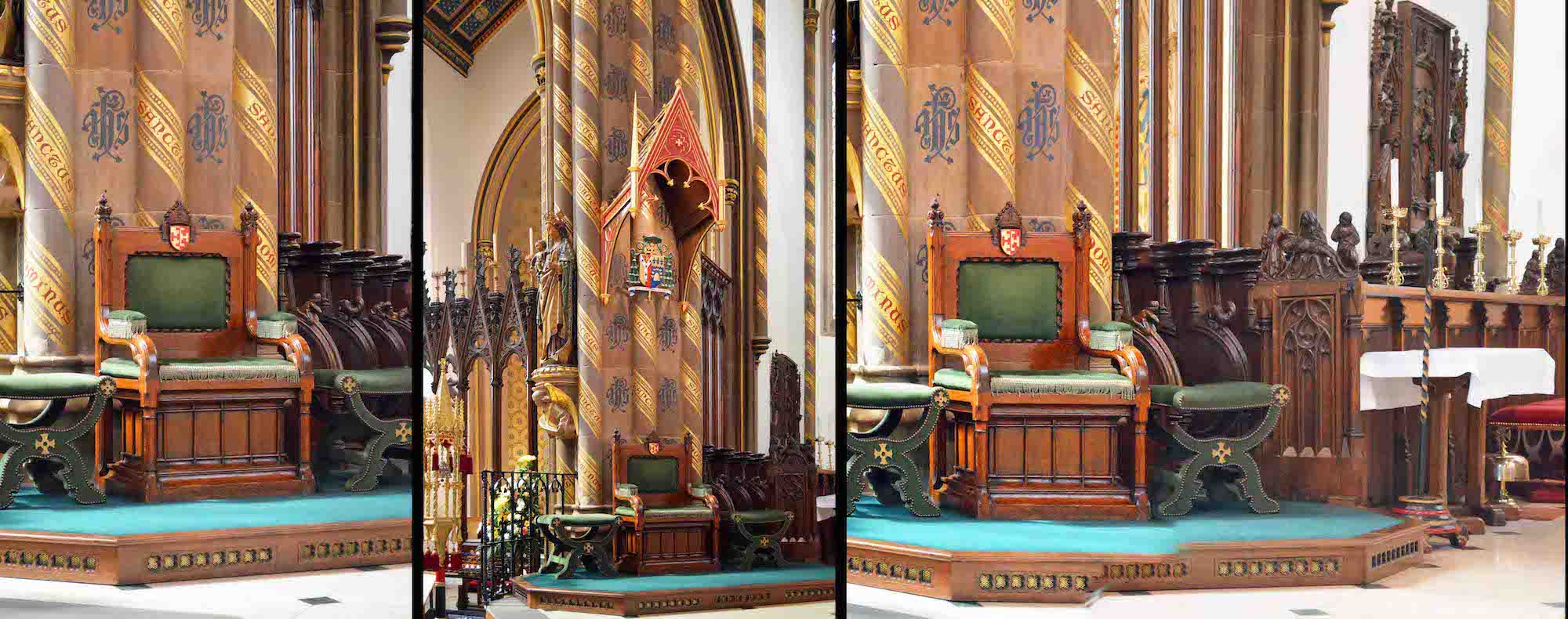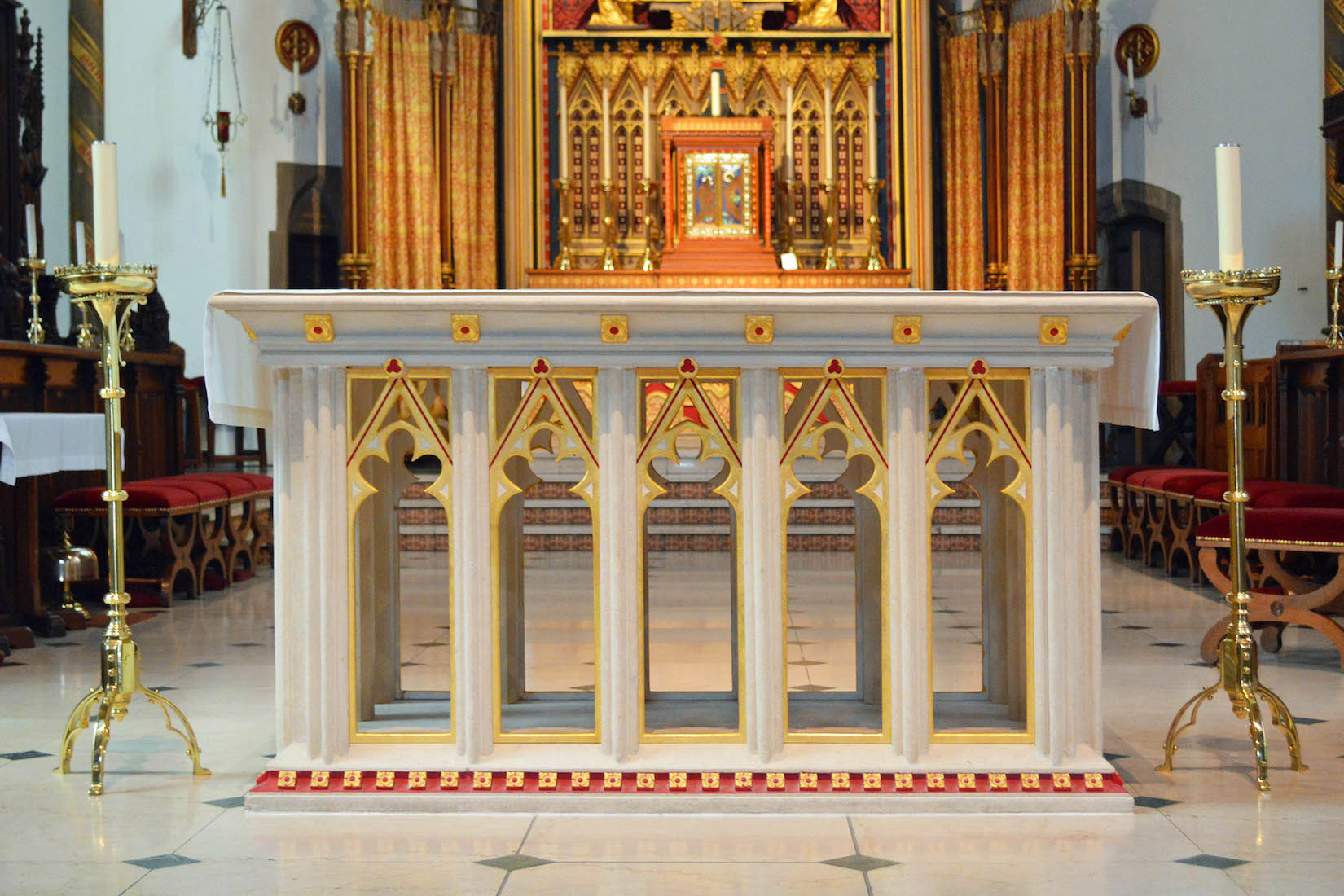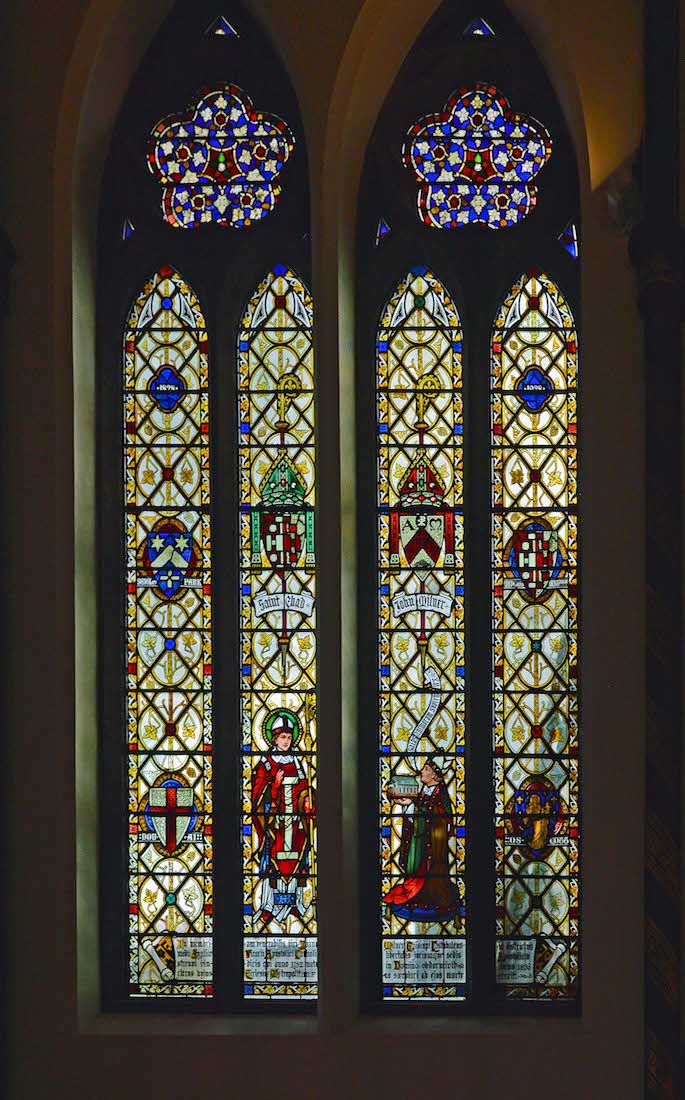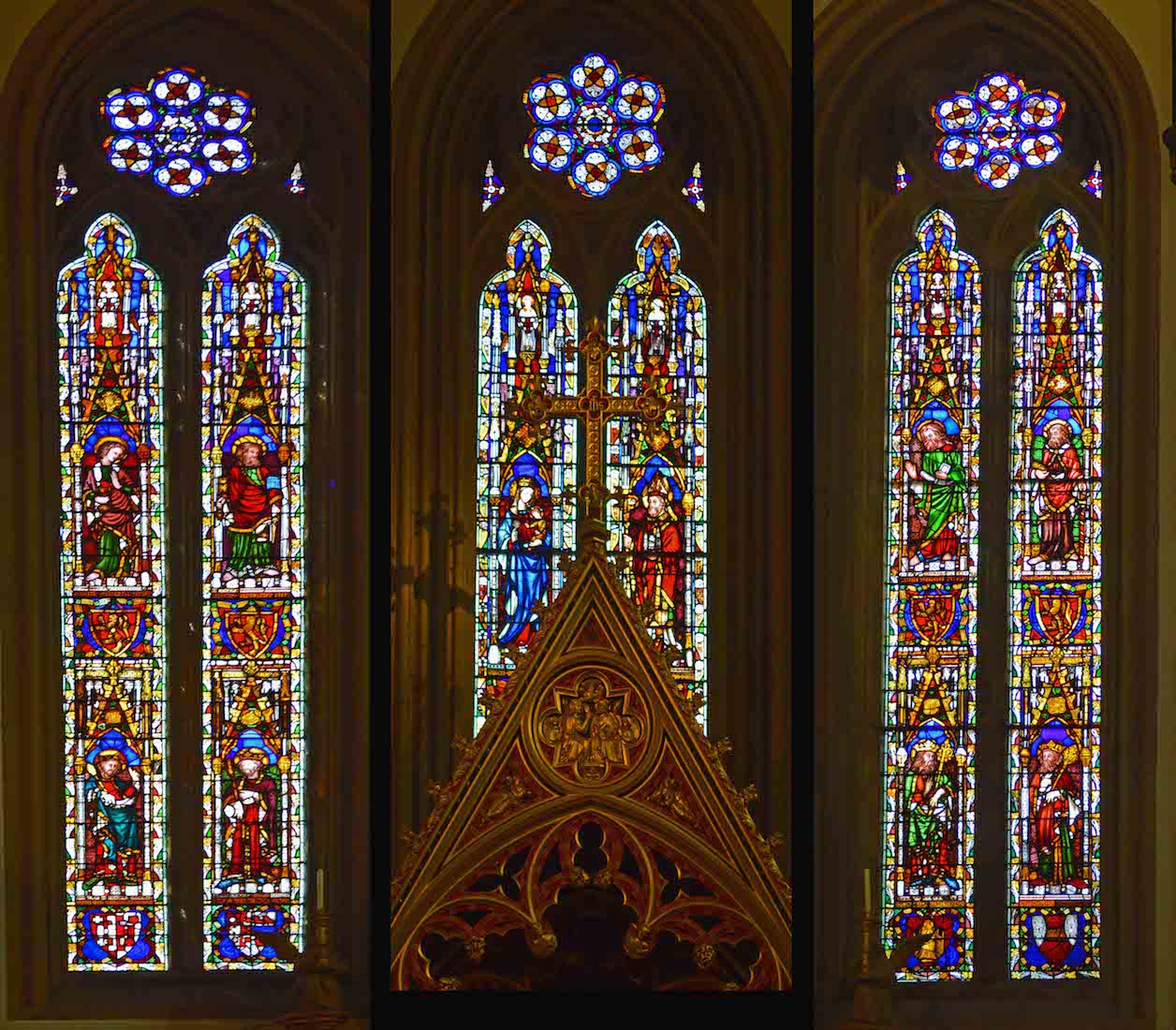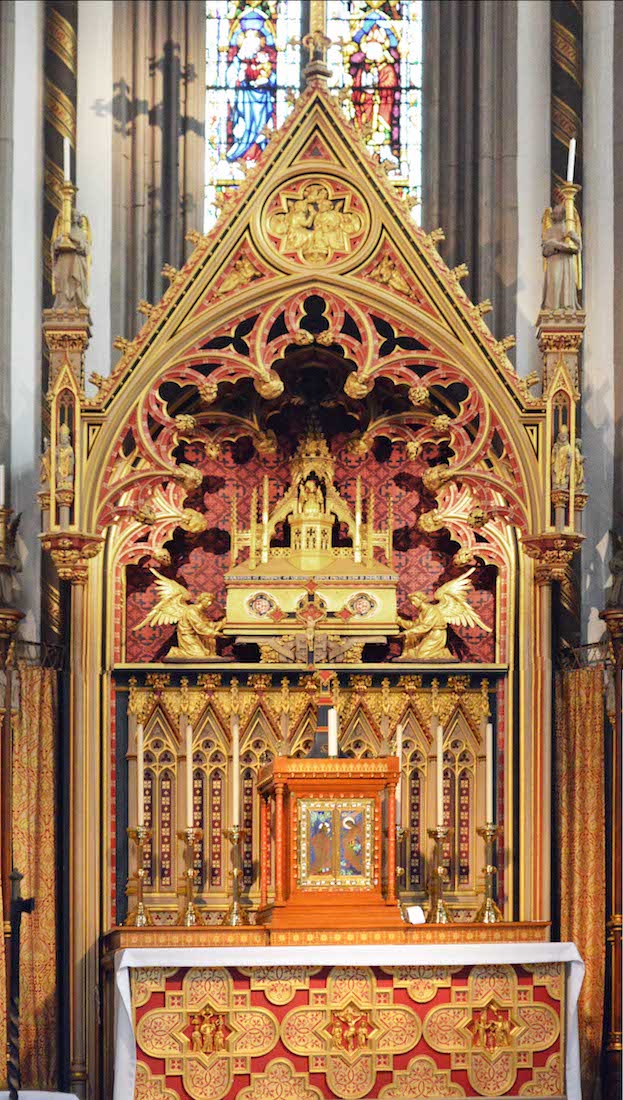41. LADY CHAPEL ALTAR AND REREDOS
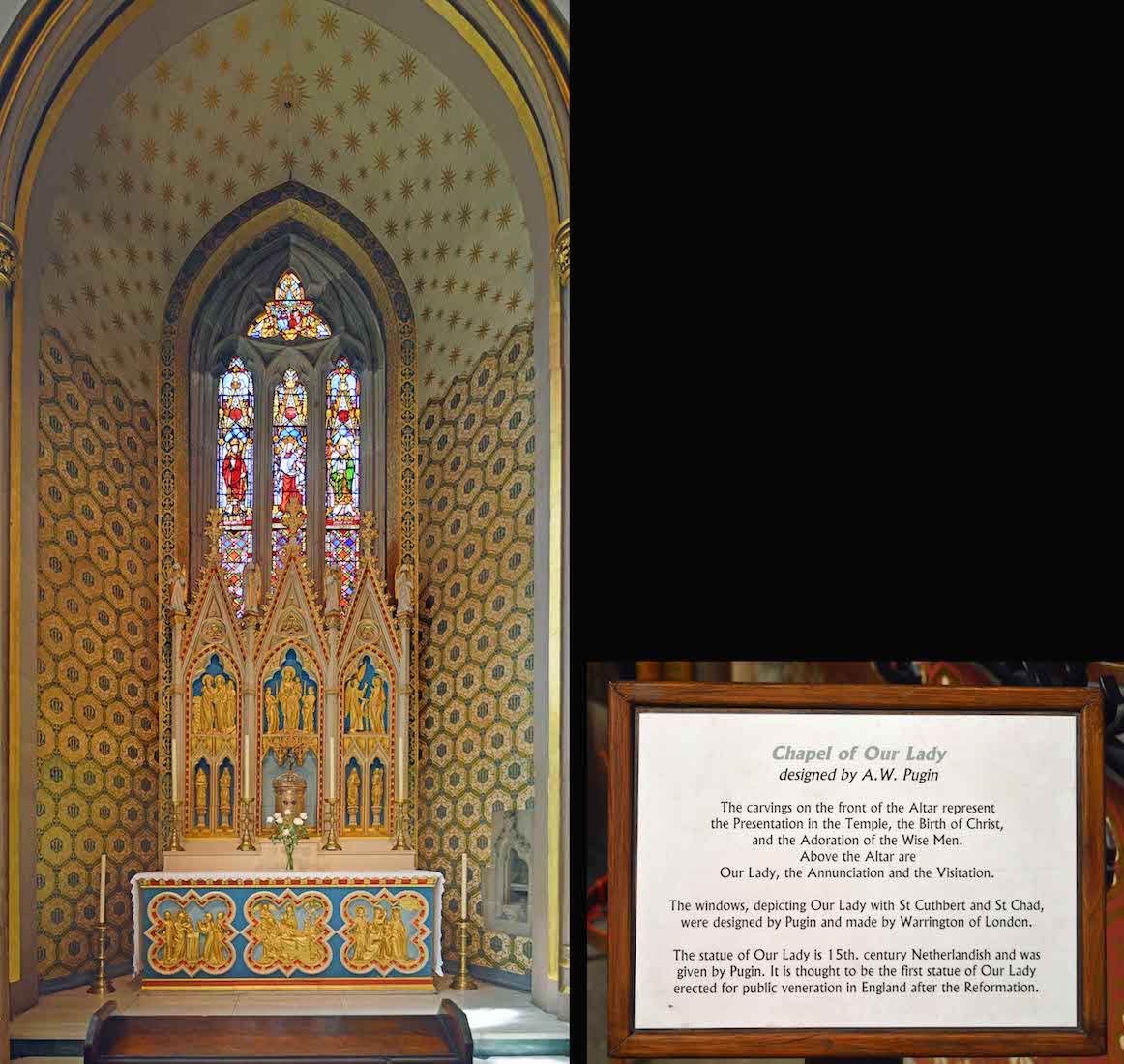
The Lady Chapel, with its screen, altar, elaborate reredos, cylindrical tabernacle and window were all designed by Pugin. The reredos shows the Visitation, with Mary and her cousin Elizabeth, the Virgin Mary with the infant Jesus, and the Annunciation, with the Angel Gabriel. Below are four female saints: Mary Magdalene, St Barbara, St Cecilia and St Catherine. The stained glass window at the back, partly obscured here, shows Mary with St Cuthbert and St. Chad. The altar carvings show the Presentation of Jesus in the Temple, the Nativity, and the Adoration of the Magi. The hounds in the nativity scene may be a reference to the Earl of Shrewsbury's family shield. PLAN
42. DIVINE MERCY AND THE PENNY WINDOW
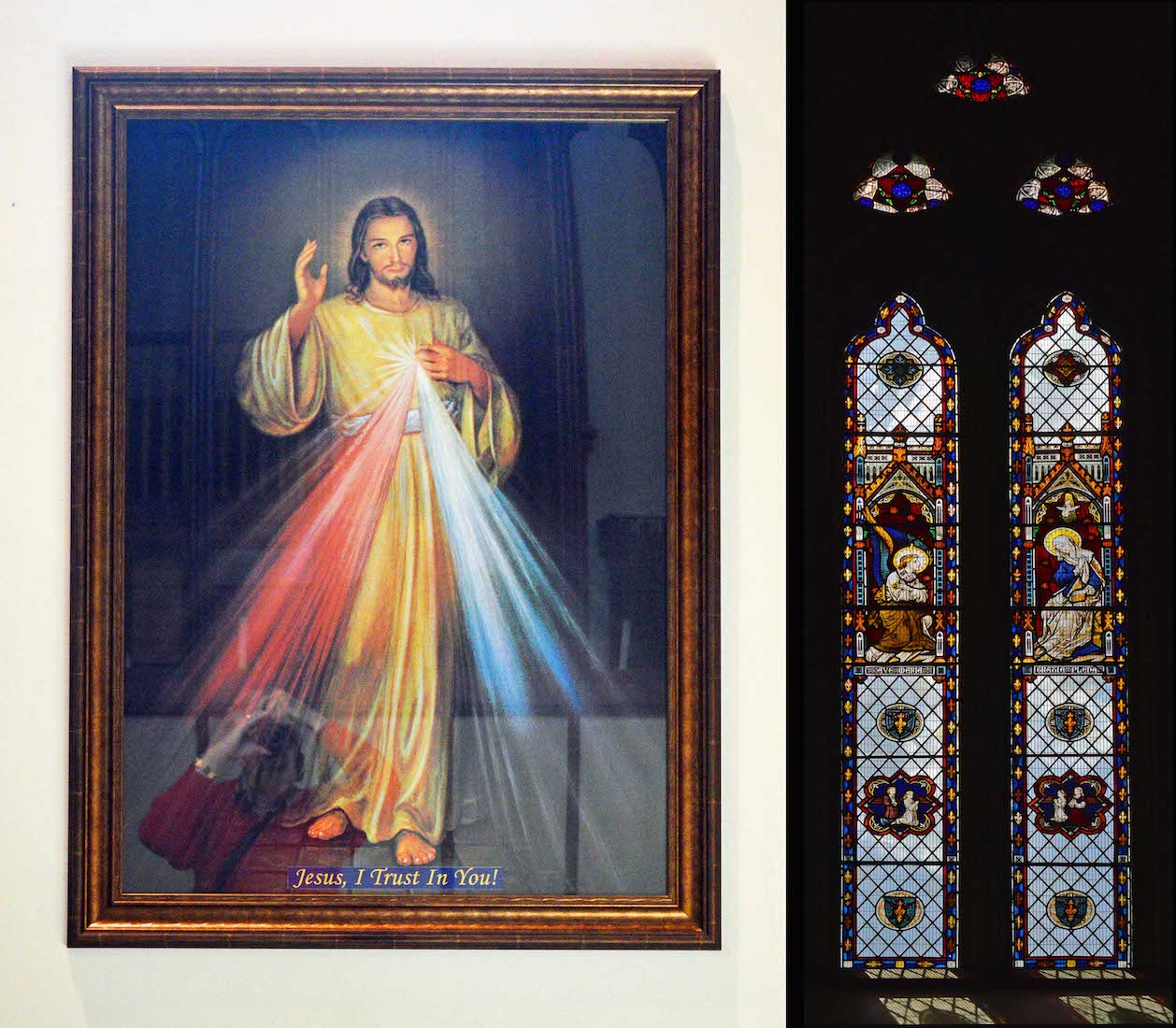
The Divine Mercy image at left is situated right next to the Lady Chapel. It is a depiction of Jesus based on the devotion initiated by Saint Faustina Kowalska. Jesus is shown raising his right hand in blessing, and pointing with his left hand to his chest from which flow forth two translucent rays: one red and one white. Close by is the Penny Window. This window was brought and paid for by the children of St Chad’s Primary School back in 1844. Some of the children’s images were used in the design of this special window.
43. SOUTH TRANSEPT
Leaving the Lady Chapel, we move back across the Cathedral to the South transept. The columns across here are nicely decorated with an ornamental spiral pattern. In the transept there is another large stained glass window – the Flanagan window. This window was installed in 1865 by John Hardman & Co, and was erected by public subscription to the memory of the Very Rev. Thomas Canon Flanagan, who died in 1865. At the time of his death he was one of the priests attached to this Cathedral Church.
44. SOUTH TRANSEPT FLANAGAN WINDOW
The window represents the life of St. Thomas of Canterbury, Canon Flanagan’s patron saint. The upper part of the window, shows the miracles wrought at his tomb at Canterbury. In the medallion in the centre of the window is seen the glorification of the Saint in heaven. Around the medallion are three angels, with the figure of Canon Flanagan himself in the lower right-hand corner. The lower part of the window shows the life of the Saint on earth.
45. BASILICA UMBRELLA
At this corner of the altar platform stands a curious red and yellow umbrella. The umbraculum is a historic piece of the papal regalia and insignia, once used on a daily basis to provide shade for the Pope. Also known as the pavilion, in modern usage the umbraculum is a symbol of the Roman Catholic Church and the authority of the Pope over it. It is found in the contemporary Church at all the basilicas throughout the world, placed prominently at the right of their main altars. Whenever the Pope visits a basilica, its umbraculum is opened.
46. VESTRY MEMORIAL
East of the South transept there is an archway. The top part of the archway is a balcony, and underneath is an area behind a grill which appears to be a (private) vestry. I spotted this ‘memorial’ through the doorway. It is in recognition of Archbishop Bernard of the Metropolitan Church of St Chad – presumably the currently serving Archbishop Bernard Longley?
47. ROOD CROSS
In church architecture the rood, or rood cross, is a life-sized crucifix displayed on the central axis of a church, normally at the chancel arch. This rood cross, designed by Pugin, has a medieval Flemish figure of Christ. Notice the sanctuary ceiling, accommodating the shape of the rounded apse.
48. CROSSING AND TRANSEPT CEILINGS
The wonderful painted patterning continues in the ceilings of crossing and transepts. A thanksgiving tablet (not shown here) appears in the design of a transept ceiling, reading ‘Deo Gratias 22 Nov 1940.’ Because the cathedral was situated in the Gunmakers’ Quarter, it was in a dangerous location during World War II. On 22 November 1940, a German incendiary bomb fell through the roof of the south aisle, bounced from the floor into some central heating pipes, and then burst. However, the water from the damaged central heating pipes put out the fire.
49. BELL, BOOK AND CANDLE
The unusual bell and stand is found on the altar platform near the pulpit. On the other side is the lectern from which the Bible would be read at services. The nearby candlestand is similar to one illustrated in the Crystal Palace catalogue, and is for the paschal candle at Easter.
50. CATHEDRA AND CHOIR STALLS
The Bishop’s Chair, or cathedra, which is made of oak, upholstered in green velvet, and decorated with the diocesan coat of arms was also designed by Pugin. The adjacent choir stalls have carved misericords which are designed to assist priests who had to stand for long periods of time during Mass; the fascinating individual carvings on each seat provided support, whilst giving the impression that the priest was still standing upright. Unfortunately we are unable to get close to these.
51. NAVE ALTAR
Like most cathedrals these days, St Chad’s has two altars: the high altar, and the nave altar shown here. This was a result of Vatican II where it was decreed that the Mass should be administered by a priest facing the congregation at an altar close to the congregation.
52. SOUTH SANCTUARY WINDOW
This window in the South sanctuary features St Chad, the patron saint of this Cathedral, and Bishop John Milner. Milner (1752–1826) was an English Roman Catholic bishop and controversialist who served as the Vicar Apostolic of the Midland District from 1803 to 1826.
53. HIGH ALTAR AND EAST SANCTUARY WINDOWS
The East sanctuary windows are the work of William Warrington. Pugin’s high altar of 1841 survives. It was paid for by John Hardman Senior and Junior, who also paid for Pugin’s rood screen (since removed). The high altar has riddel posts and an elaborately carved gable with cusped arch enclosing the relic chest of Saint Chad, with the crowning spire (Gerald Hardman) added in 1933.
54. EAST SANCTUARY WINDOWS
In the stained glass window to the left, Pugin shows St John the Evangelist and St Peter, above St Michael and St Edmund. The central East window is somewhat obscured by the altar, but shows Mary holding the infant Jesus, beside St Chad with his mitre and red chasuble. I can find no reference describing the right window. All three apse windows were the gift of the Earl of Shrewsbury. The windows were executed for Pugin by William Warrington.
55. RELIQUARY AND TABERNACLE
The finely-wrought casket on the altar was also designed by Pugin. It is a reliquary — a container for the relics of St Chad. The enamel tabernacle was designed by Joseph Aloysius Pippet. It is designed in what is known as the arts and crafts style – standing for traditional craftsmanship using simple forms and it often used mediaeval, romantic or folk styles of decoration. This completes our tour of St Chad’s Cathedral.

CONCLUSION
I hope you have enjoyed visiting the St Chad’s Catholic Cathedral, Birmingham with me. It is an historic cathedral with a number of interesting features.
I am happy to receive constructive comments or corrections concerning this website. The best websites are the ones which have no errors! I am grateful to my wife Margie who came with me, and who has proof-read these pages.
The Cathedral has an interesting website, and I have drawn heavily on this and other related sites for the text used here. I am happy to acknowledge these sources.
The link for the Cathedral website is:
https://www.stchadscathedral.org.uk/
The Cathedral website speaks of a published Cathedral guide, but I was unable to obtain a copy of this during my visit. The photographs which appear on this site are all mine, and can also be found in higher resolution at:
https://www.flickr.com/photos/paulscottinfo/sets/
Paul Scott Site created 9 / 2017; reformatted 05 / 2020.

